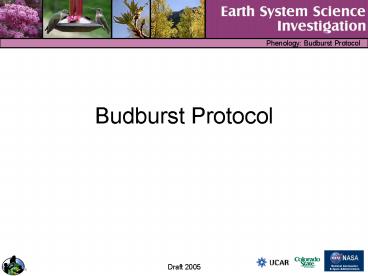Budburst Protocol - PowerPoint PPT Presentation
1 / 16
Title:
Budburst Protocol
Description:
... soil temperature, soil moisture, and day length affect plant growth ... Flag at least two trees from each species. Draft 2005. Phenology: Budburst Protocol ... – PowerPoint PPT presentation
Number of Views:57
Avg rating:3.0/5.0
Title: Budburst Protocol
1
Budburst Protocol
2
Goals for the Training Session
- Provide an inquiry context for the data
collection and science content - Provide accurate science content
- Review procedures for data collection
- Review data entry and analysis
- Discuss classroom implementation ideas
- Collect feedback from participants
3
Inquiry Context
- When does budburst occur for the dominant tree
species? - How does budburst differ between different tree
and shrub species within a forested study area? - How does budburst vary year to year for the same
species? - Which environmental factors most affect the
timing of budburst on a particular species?
4
Local Inquiry Example
5
Why do GLOBE scientists research budburst?
- To calculate growing season length and monitor
interannual changes in growing season duration - To determine how environmental conditions such as
air and soil temperature, soil moisture, and day
length affect plant growth - To monitor the nature and extent of climate
change and its effects on plants and animals - To help interpret satellite observations of
greenness
6
Science Content What is Budburst?
Dormancy is a state of suspended growth and
metabolism. Budburst is the emergence of new
leaves (photosynthetically active foliage) on
plants, which signals the beginning of a new
growing season cycle.
Dormant Bud
Budburst
7
Instruments Budburst
- GPS Receiver
- Local Tree Identification Guide
- Flagging Tape Marker
- Binoculars (optional)
8
The Measurements
- Budburst Study Site Definition
- GPS Measurement
- Tree/Shrub Species
- Budburst Protocol
- Date buds burst on 3 or more places of the same
plant
9
Collecting Data Field/Lab Guides Data Sheets
- Field/Lab Guides
- Budburst Site Definition Field Guide
- GPS Protocol or Offset GPS Protocol Field Guide
- Budburst Protocol Field Guide
- Data Sheets
- Budburst Site Definition Sheet
- GPS Investigation Data Sheet
- Budburst Protocol Data Sheet
10
Collecting Data Budburst Study Site
- Site Selection
- At least 2 weeks before budburst
- Convenient location
- Native trees that are minimally watered or
fertilized are preferred
- Tree Selection
- Identify dominant tree species
- Choose measurement strategy
- Dominant overstory species
- More than one overstory species
- Overstory and/or understory species
- Flag at least two trees from each species
11
Collecting Data Budburst Protocol
- Observe selected trees at least two weeks prior
to budburst - Visit twice a week, initially until budburst
appears anywhere on tree - Visit daily until budburst is seen on three
separate locations of each tree
12
Enter Data on the GLOBE Web SiteBudburst Study
Site Definition
Step 1 Select Define a Budburst Study Site
from the Phenology data entry menu Step 2 Enter
the Study Site information Step 3 Click Send
Data Step 4 Confirm data entries on
verification page
13
Enter Data on the GLOBE Web SiteBudburst Protocol
Step 1 Confirm that the budburst study site
definition is complete Step 2 Select Budburst
from the Phenology data entry menu Step 3 Enter
the year chose the site you defined Step 4 For
each tree, enter the date of budburst and the
date of last observation prior to budburst Step
5 Confirm data entries on verification page
14
Looking at the Data
15
Classroom Implementation
- Inquiry
- Curriculum/Standards Alignment
- Assessment
- Classroom Management
16
Getting Started
- The GLOBE Web site has information
- http//www.globe.gov
- GLOBE Help Desk or your Country Coordinator can
support you as you get started. - Get your students involved doing real science!































